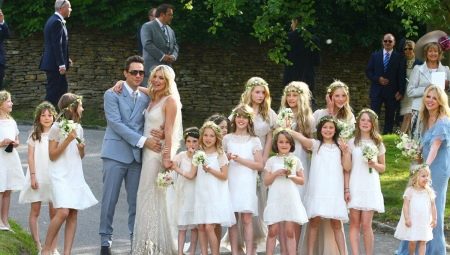Russian wedding is an interesting symbiosis of ancient national traditions, trends of the Soviet era and elements of Western style. Although many couples prefer to celebrate the wedding in a Western manner (exit registration, replacing the host with a host, the absence of competitions, a harmonist, traditional redemption and meeting with bread and salt), most marriages adhere to classical traditions.
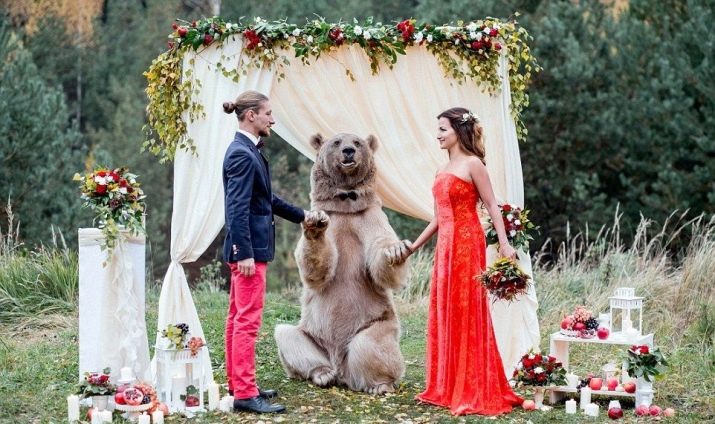
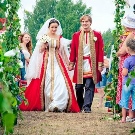
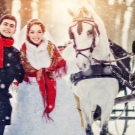
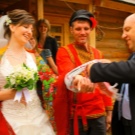
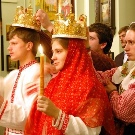
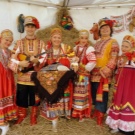
Matchmaking
In ancient times, before sending matchmakers to the bride's house, they were carefully selected. As a rule, kinsmen became relatives. The main purpose of the matchmaker is to be an authoritative person in the eyes of others and to know what to say in a given situation. The peculiarities of weddings in Russia were that the bride was not familiar with the future spouse before the wedding, and it was up to the skill of the matchmakers whether the wedding would take place at all.
Only by their speeches could one understand how good the groom was in his characteristics and qualities. Matchmaking has always been accompanied by jokes, songs, dances.
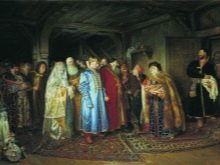


As part of the matchmaking, many symbolic rites were performed, some of which are still observed today.
Loaf
This attribute was most often brought by matchmakers from the groom. If the girl agreed to the wedding, she cut the loaf into pieces and distributed to everyone present, starting with her parents. Loaf had to be eaten to the last bite - then the future marriage was considered successful and happy.

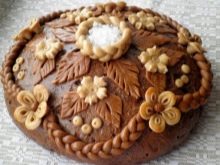

Towel
This attribute was used to dress the matchmakers, if the girl agreed to the wedding. The matchmakers presented a rushnyk as a gift from the parents of the bride to the parents of the groom.
Today, rushnyk is used at the matchmaking as a dish under the loaf. After the matchmaking - stored until the solemn day.


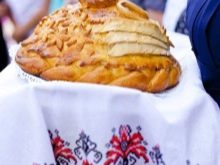
There were certain dates and even days when the outcome of the matchmaking could end most successfully. These numbers included the 3rd, 5th, 7th and 9th of each month, as well as October 14th. The last date was especially significant, since it accounted for the feast of the Protection of the Holy Virgin. It was impossible to get married on the 13th of any month. Among the days of the week, matchmaking was best suited for the weekend, Tuesday and Thursday.
Matchmakers, once in the house of the future bride, never openly declared the purpose of their visit. They talked with the owners of the house on abstract topics, and then came up to the point from a distance. Parents of the bride welcomed guests, treated to drinks (they were served by the future bride).
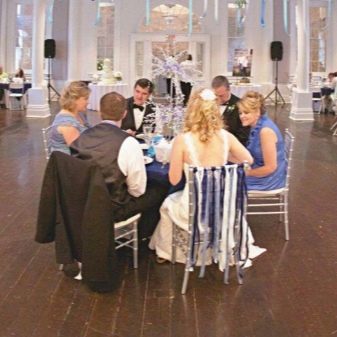

At this time, the matchmakers looked closely at the girl, began to question about her and praise the groom. If the bridegroom received a refusal, then, as a rule, it was a very laconic answer: “Our apple has not poured yet”, “Our goods are not for sale”, “They have not accumulated enough dowry” and others.
If the outcome of the matchmaking was positive, then after discussing organizational issues, the bride gave the narrowed collateral - a handkerchief.
A piece of the loaf was wrapped in a scarf, and the matchmaker carried it, lifting it up, so that everyone could see that the matchmaking was successful and the wedding would take place soon.
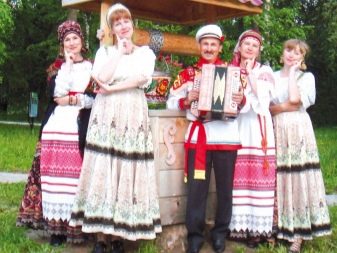
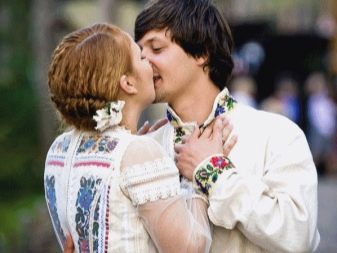
Today, lovers make the decision about the wedding themselves. Only after that, parents and other relatives learn about the upcoming event. Of course, matchmaking in many families is still held today (as a certain tribute to the old traditions, parents). It is during this pre-wedding ceremony that the bride’s parents can better see and recognize the groom.
Today, matchmaking is conducted in a simplified form. Matchmakers do not arrange theatrical scenes, they sing a little and do not say jokes. The groom, going into the bride’s house, presents flowers to all the women present. Matchmakers bring fruit, alcohol, sweets. The bride receives a valuable gift from the groom and future mother-in-law and mother-in-law.




Most often this is a piece of jewelry, but it can also be an old heirloom. An inexpensive gift is presented to the parents of the bride, but with the meaning: a horseshoe (a talisman for housing), a beautiful candle (for comfort and warmth in the house), a photo album (for good memories) and others. As soon as there was an exchange of gifts and mutual greetings, all those present are invited to the table, where there is a discussion of the details of the future wedding.
To matchmaking does not turn into a boring evening, you need to choose the right matchmakers. The most suitable option is talkative natures who are not burdened with constraint, complexes that can captivate everyone behind them.



The groom, who came with the matchmakers, must remain silent. Matchmakers should shine with eloquence. Having greeted all those present and reporting the purpose of the visit, the matchmakers can come up with a whole kaleidoscope of comic trials and tricky questions for the bride. The same tasks, carefully prepared by the relatives of the bride, are waiting for the groom.
In the midst of matchmaking with characteristic jokes-jokes stands apart the moment of marriage proposal. At this moment, the groom and the bride's parents must be very serious, but sincere. The groom may ask the parents to give the daughter out for him at the very beginning of the meeting or at the table.



After everyone was announced about the engagement, the main wedding chores began. The bride, along with household chores, had to prepare a dowry and sew a wedding dress. In the remote villages there was even a custom to go out on the porch of the father’s house every day, sob and lament about the fear of entering a new life. Today, such a ritual is no longer being observed.
In addition, on the eve of the wedding, a bachelorette party was held. Today, in Russia, the bachelorette party is celebrated very lushly and loudly, in ancient times it was a fairly quiet evening with sad songs.
The bridesmaids braided her braid, weaving satin ribbons, then they unraveled.
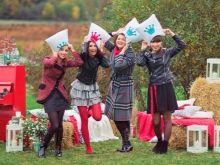

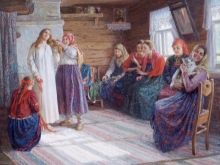
It was believed that in this way the bride says goodbye to her former unmarried life. The bride herself cried and wailed. Ribbons from the braids of the bride were considered endowed with meaning: girlfriends took them apart and stored them for good luck and speedy marriage.
The pre-wedding preparation by the groom consisted of baking a huge painted loaf decorated with flowers, figures and interesting patterns from the dough. The entire female half of the house, under the loaf songs, was engaged in the creation of this culinary masterpiece until dawn. The groom spent the bachelor party on the eve of the wedding. His relatives and friends attended this evening.



Ransom bride
In Russia, the ransom of the bride was a very responsible matter, requiring considerable generosity from the groom. Today, the monetary component has already receded into the background. The main purpose of the ransom today: passing all the test trials prepared by the bridesmaids, the groom proves to everyone how well he knows and loves his future wife. Friends from the groom can always come to his aid, if necessary.
After the ransom is completed, the bride's parents organize a small table for those present.
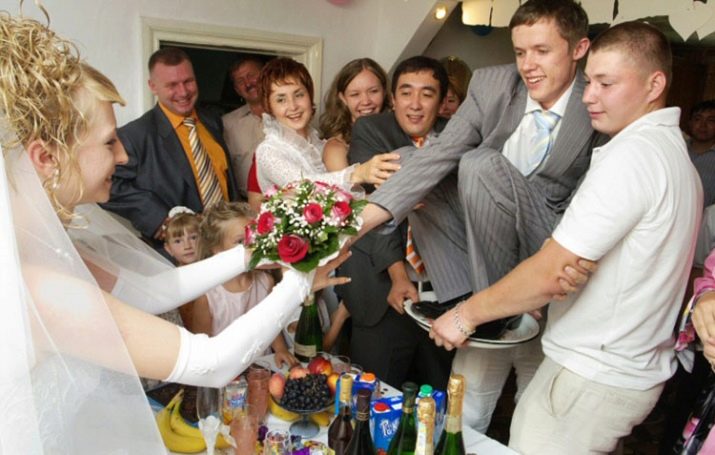


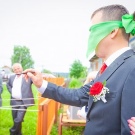
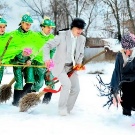
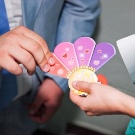
Wedding ceremony
The wedding takes on a new color after the official ceremony at the registry office. Many modern couples delight themselves and guests in the hall for official ceremonies not only with their first kiss, but also with their first dance (you must first agree on a specific composition).
After the official part of the guests, a photo session with young people awaits. Then the guests of the holiday should be on both sides of the exit from the registry office in order to shower young rose petals, rice, coins or sweets.



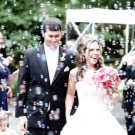
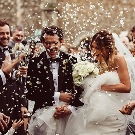
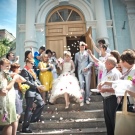
According to popular beliefs, this rite (depending on the selected products) gives young people wealth, healthy offspring, a romantic and sweet life together. If the newlyweds are true believers, then according to the customs of the Russian people, on the same day they undergo a wedding ceremony.
After official events, festive celebrations begin. Usually only the closest friends are involved in them.
In order to keep colorful photographs in their memory, young people visit and conduct a photo shoot in the most picturesque corners of the city.



The bridegroom carrying the bride across the bridge is also an integral tradition of Russian weddings. According to legend, the young must do the same procedure on seven bridges, then their union will be strong. But in the conditions of modern celebrations and the busyness of the main city highways, this is not always possible to do, therefore tradition is respected, but the number of objects is reduced to one. A memorial castle with the initials of the young is left there as a symbol of the fortress of marriage.
After marriage, in Russia, after the wedding, they visited the father's house of the groom. The mother-in-law met them with bread and salt (loaf), and the mother-in-law at that time held icons. The bride and groom were to bite off part of the loaf. The head of the family was determined by the size of the bitten off piece. At the same time, the ceremony of blessing the new family took place. Today, a meeting with a loaf is increasingly held in the banquet hall in the presence of guests.



Outfits
The first thing at a wedding is always pay attention to the bride's dress. Its color, in most cases, is white. The bride gets a new dress, although some girls prefer to wear their mother's dress on a solemn day, wanting to inherit her happy family life. A new dress is a symbol of entry into a new life, and white is a symbol of youth and purity. That is why women who marry several times put on dresses of blue or beige shades at subsequent ceremonies.
If in Russia the wedding dress was always bright red, then at modern celebrations you can see brides in white robes with bright accents or delicate pastel shades.
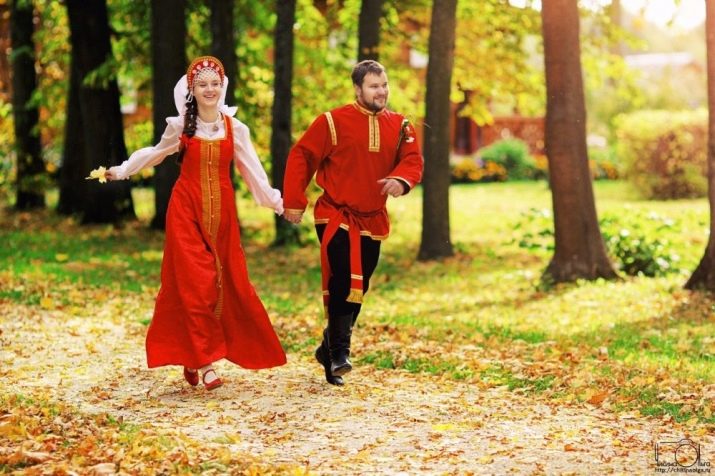



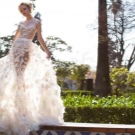

Red color today is the lot of bold and extraordinary personalities. Veils at modern weddings have become optional. She is perceived as a decoration of hairstyles. You can replace the veil with a hat with a veil.
According to popular beliefs, there should be something old in the vestments of the bride. Most often, these are family decorations or an element from mom’s wedding dress. This attribute is a symbol of intergenerational communication. Also, the outfit must contain a part borrowed from a girlfriend. It is believed that then close friends will always be close to the young ones, ready to help in difficult times.
In order for harmony to reign in a young family, the bride should have something of a blue color: a garter, accessory, dress element that makes up makeup.
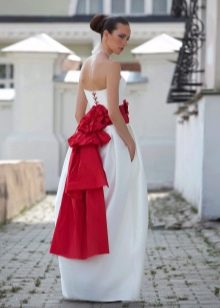


Feast
The wedding script is designed in such a way that the main place in it is occupied by congratulations. The first to do this are always invited parents. Then the word is given to relatives and friends. In order for the money envelopes not to form a messy pile, and not be lost at all by the end of the evening, the bride herself or her bridesmaids specially make a box with a slot. The witness helps the bride to collect gifts in cash on the day of the celebration.

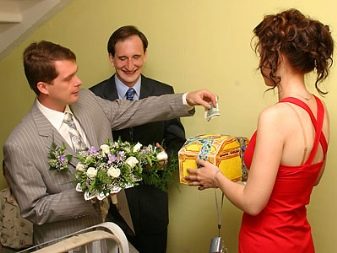
After the first toasts and snacks, guests are invited to the dance floor. By tradition, the first dance always remains with the young (if it was not in the registry office). Today it’s very fashionable to do staged dances, for which the bride and groom are diligently engaged in a dance studio for several months. For spectacular performance, the bride and groom can wear other outfits for a while.
Another traditional dance during the feast is the bride’s dance with her father. With this action, he blesses his daughter for a happy life in another family.



When the wedding celebrations come to an end, the host announces the need to transfer the family hearth from parents to children. This ceremony is carried out as follows:
- candles are given to everyone present;
- all go out into the middle of the room, stand in a circle and light candles;
- the light in the room is off;
- silent slow music sounds in the background, during which the host talks about the significance of this tradition;
- young parents on both sides light their candles and go to the center of the hall, standing next to their children, light from their candles a home for a new family.
At the end of the wedding, the mother of the bride or a newly-made mother-in-law helps the girl to remove the veil. At first she must resist this, but after persuasion she must agree. After that, the young husband unleashes a spit to his wife. Toastmaster at this time tells the story of this custom.

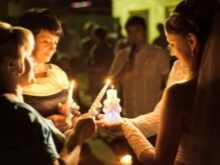

Gifts
In the old days, the most common wedding gifts were:
- livestock (cow, horse, piglet, chicken, ducks);
- a set of towels without fringe;
- lash.
All of them had a symbolic meaning. Animals symbolized the appearance of healthy babies, towels - a smooth life, a lash - the primacy of the husband in the family.
Today it’s customary to give money, utensils, computer and household appliances, bedding, cutlery, audio and video equipment for a wedding.
Recently, pre-ordering gifts is widespread: newlyweds long before the wedding notify guests about what they would like to receive.



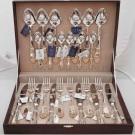


Traditions on the second and third day of the celebration
Very rarely, a Russian wedding is celebrated one day. As a rule, the day following the celebration implies an informal setting. The second day is celebrated in the bosom of nature - with barbecue, spirits, songs. And already on the third day, the couple can go on a honeymoon to some hot exotic country.






About Russian wedding traditions, see the video below.
